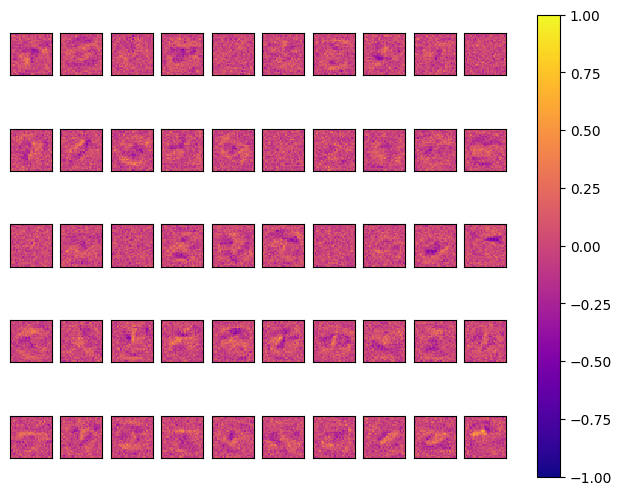Credits: Raschka et al, Chap 11
12. Building a Multi-layer Artificial Neural Network from Scratch#
from IPython.display import Image
%matplotlib inline
import numpy as np
import matplotlib.pyplot as plt
from IPython.display import display
display(Image(url="https://raw.githubusercontent.com/cfteach/NNDL_DATA621/webpage-src/DATA621/DATA621/images/multi-layer-NN.png", width=600))

12.1. Classifying handwritten digits#
The MNIST dataset is publicly available at http://yann.lecun.com/exdb/mnist/ and consists of the following four parts:
Training set images: train-images-idx3-ubyte.gz (9.9 MB, 47 MB unzipped, 60,000 examples)
Training set labels: train-labels-idx1-ubyte.gz (29 KB, 60 KB unzipped, 60,000 labels)
Test set images: t10k-images-idx3-ubyte.gz (1.6 MB, 7.8 MB, 10,000 examples)
Test set labels: t10k-labels-idx1-ubyte.gz (5 KB, 10 KB unzipped, 10,000 labels)
from sklearn.datasets import fetch_openml
X, y = fetch_openml('mnist_784', version=1, return_X_y=True)
X = X.values
y = y.astype(int).values
print(X.shape)
print(y.shape)
(70000, 784)
(70000,)
Normalize to [-1, 1] range:
X = ((X / 255.) - .5) * 2
print(X.shape)
(70000, 784)
# to familiarize
print(np.shape(X[y == 7])) # all digits == 7
print(np.shape(X[y == 7][2])) # visualize second example among those with label 7
(7293, 784)
(784,)
Visualize the first digit of each class:
import matplotlib.pyplot as plt
fig, ax = plt.subplots(nrows=2, ncols=5, sharex=True, sharey=True)
ax = ax.flatten() #flattening the matrix of subplots
for i in range(10):
img = X[y == i][0].reshape(28, 28) #creates a boolean mask with all images coincident with one specific digit. Of which we take the first.
ax[i].imshow(img, cmap='Greys')
ax[0].set_xticks([])
ax[0].set_yticks([])
plt.tight_layout() # Adjusts spacing
plt.show()
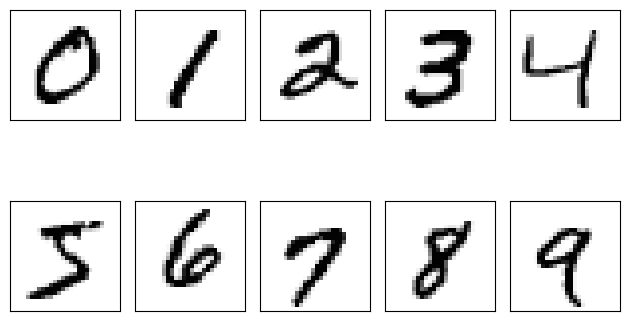
Visualize 25 different versions of “7”:
fig, ax = plt.subplots(nrows=5, ncols=5, sharex=True, sharey=True)
ax = ax.flatten()
for i in range(25):
img = X[y == 7][i].reshape(28, 28)
ax[i].imshow(img, cmap='Greys')
ax[0].set_xticks([])
ax[0].set_yticks([])
plt.tight_layout()
# plt.savefig('figures/11_5.png', dpi=300)
plt.show()
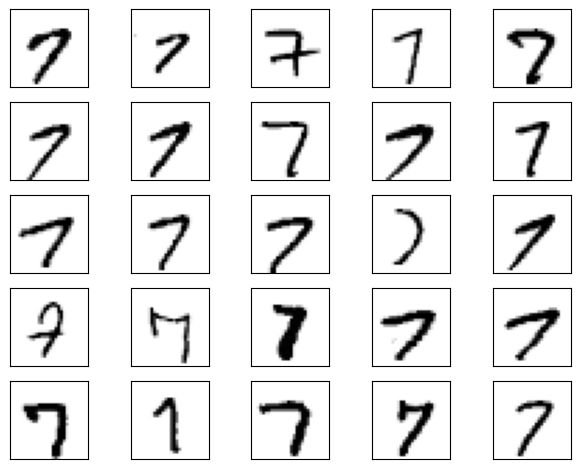
Split into training, validation, and test set:
from sklearn.model_selection import train_test_split
X_temp, X_test, y_temp, y_test = train_test_split(
X, y, test_size=10000, random_state=123, stratify=y)
X_train, X_valid, y_train, y_valid = train_test_split(
X_temp, y_temp, test_size=5000, random_state=123, stratify=y_temp)
# optional to free up some memory by deleting non-used arrays:
del X_temp, y_temp, X, y
12.2. Modeling a Multi-Layer Perceptron (MLP)#
##########################
### MODEL
##########################
def sigmoid(z):
return 1. / (1. + np.exp(-z))
def int_to_onehot(y, num_labels):
ary = np.zeros((y.shape[0], num_labels)) # [n_examples, n_classes]
for i, val in enumerate(y):
ary[i, val] = 1
return ary
class InitializeModel:
def __init__(self, random_seed=123):
print("Model initialization")
self.random_seed = random_seed
# Set up a common random number generator
self.rng = np.random.RandomState(random_seed)
# Common attribute for all models
self.operation = "Initialization"
class NeuralNetMLP(InitializeModel):
def __init__(self, num_features, num_hidden, num_classes, random_seed=123):
super().__init__(random_seed)
"""
self.num_classes = num_classes
# hidden
#rng = np.random.RandomState(random_seed)
self.weight_h = self.rng.normal(
loc=0.0, scale=0.1, size=(num_hidden, num_features))
self.bias_h = np.zeros(num_hidden)
# output
self.weight_out = self.rng.normal(
loc=0.0, scale=0.1, size=(num_classes, num_hidden))
self.bias_out = np.zeros(num_classes)
"""
self.num_classes = num_classes
self.num_features = num_features
self.num_hidden = num_hidden
self._initialize_weights()
def _initialize_weights(self):
"""Initialize weights and biases with random values."""
# Initialize hidden layer weights and biases
self.weight_h = self.rng.normal(
loc=0.0, scale=0.1, size=(self.num_hidden, self.num_features))
self.bias_h = np.zeros(self.num_hidden)
# Initialize output layer weights and biases
self.weight_out = self.rng.normal(
loc=0.0, scale=0.1, size=(self.num_classes, self.num_hidden))
self.bias_out = np.zeros(self.num_classes)
def reinitialize(self, random_seed=None):
"""Reinitialize the model weights and biases if you need to."""
if random_seed is not None:
self.rng = np.random.RandomState(random_seed)
self._initialize_weights()
def forward(self, x):
# Hidden layer
# input dim: [n_examples, n_features] dot [n_hidden, n_features].T
# output dim: [n_examples, n_hidden]
z_h = np.dot(x, self.weight_h.T) + self.bias_h
a_h = sigmoid(z_h)
# Output layer
# input dim: [n_examples, n_hidden] dot [n_classes, n_hidden].T
# output dim: [n_examples, n_classes]
z_out = np.dot(a_h, self.weight_out.T) + self.bias_out
a_out = sigmoid(z_out)
return a_h, a_out
def backward(self, x, a_h, a_out, y):
#########################
### Output layer weights
#########################
# onehot encoding
y_onehot = int_to_onehot(y, self.num_classes)
# For simplicity, the loss function is assumed to be the same we saw in Adaline, that is an MSE
# Loss = 1/n \sum_{i=1}^{n} 1/t \sum_{j=1}^{t} (y^{i}_{j}-outa^{i}_{j})^2
# Later on we will look at other loss functions such as multi-category cross-entropy loss
#################################
# Part 1: dLoss/dOutWeights
## = dLoss/dOutAct * dOutAct/dOutZ * dOutz/dOutWeight
## where DeltaOut = dLoss/dOutAct * dOutAct/dOutZ
## for convenient re-use
# input/output dim: [n_examples, n_classes]
d_loss__d_a_out = 2.*(a_out - y_onehot) / y.shape[0]
# input/output dim: [n_examples, n_classes]
d_a_out__d_z_out = a_out * (1. - a_out) # sigmoid derivative
# output dim: [n_examples, n_classes]
delta_out = d_loss__d_a_out * d_a_out__d_z_out # "delta (rule) placeholder"
# gradient for output weights
# [n_examples, n_hidden]
d_z_out__dw_out = a_h
# input dim: [n_classes, n_examples] dot [n_examples, n_hidden]
# output dim: [n_classes, n_hidden]
d_loss__dw_out = np.dot(delta_out.T, d_z_out__dw_out)
d_loss__db_out = np.sum(delta_out, axis=0) # [n_classes]
#################################
# Part 2: dLoss/dHiddenWeights
## = DeltaOut * dOutZ/dHiddenAct * dHiddenAct/dHiddenZ * dHiddenZ/dWeight
# [n_classes, n_hidden]
d_z_out__a_h = self.weight_out
# output dim: [n_examples, n_hidden]
d_loss__a_h = np.dot(delta_out, d_z_out__a_h)
# [n_examples, n_hidden]
d_a_h__d_z_h = a_h * (1. - a_h) # sigmoid derivative
# [n_examples, n_features]
d_z_h__d_w_h = x
# output dim: [n_hidden, n_features]
d_loss__d_w_h = np.dot((d_loss__a_h * d_a_h__d_z_h).T, d_z_h__d_w_h)
d_loss__d_b_h = np.sum((d_loss__a_h * d_a_h__d_z_h), axis=0)
return (d_loss__dw_out, d_loss__db_out,
d_loss__d_w_h, d_loss__d_b_h)
#********************************************************#
#****************** THE MODEL *********************#
#********************************************************#
model = NeuralNetMLP(num_features=28*28,
num_hidden=50,
num_classes=10)
#********************************************************#
#********************************************************#
#********************************************************#
Model initialization
12.3. Coding the neural network training loop#
Defining data loaders:
num_epochs = 50
minibatch_size = 100
def minibatch_generator(X, y, minibatch_size):
indices = np.arange(X.shape[0]) # this is the number of examples
np.random.shuffle(indices)
for start_idx in range(0, indices.shape[0] - minibatch_size
+ 1, minibatch_size):
batch_idx = indices[start_idx:start_idx + minibatch_size]
yield X[batch_idx], y[batch_idx] # does not execute the function immediately, returs a generator object
#------------ let's check dimensionality --------------#
# iterate over training epochs
for i in range(num_epochs):
# iterate over minibatches
minibatch_gen = minibatch_generator(
X_train, y_train, minibatch_size)
for X_train_mini, y_train_mini in minibatch_gen:
break
break
print(X_train_mini.shape)
print(y_train_mini.shape)
(100, 784)
(100,)
Defining a function to compute the loss and accuracy
def mse_loss(targets, probas, num_labels=10):
onehot_targets = int_to_onehot(targets, num_labels=num_labels)
return np.mean((onehot_targets - probas)**2)
def accuracy(targets, predicted_labels):
return np.mean(predicted_labels == targets)
_, probas = model.forward(X_valid)
mse = mse_loss(y_valid, probas)
predicted_labels = np.argmax(probas, axis=1) # to label take the argument corresponding to the maximum probability among the 10 predicted probabilities
acc = accuracy(y_valid, predicted_labels)
print(f'Initial validation MSE: {mse:.1f}')
print(f'Initial validation accuracy: {acc*100:.1f}%')
Initial validation MSE: 0.3
Initial validation accuracy: 9.4%
# Initial validation MSE: 0.3
# Initial validation accuracy: 9.4%
# do these results make sense?
# at any given epoch
def compute_mse_and_acc(nnet, X, y, num_labels=10, minibatch_size=100):
mse, correct_pred, num_examples = 0., 0, 0
minibatch_gen = minibatch_generator(X, y, minibatch_size)
# compute through mini-batches: more memory efficient
for i, (features, targets) in enumerate(minibatch_gen):
_, probas = nnet.forward(features)
predicted_labels = np.argmax(probas, axis=1)
onehot_targets = int_to_onehot(targets, num_labels=num_labels)
loss = np.mean((onehot_targets - probas)**2)
correct_pred += (predicted_labels == targets).sum()
num_examples += targets.shape[0]
mse += loss
mse = mse/(i+1)
acc = correct_pred/num_examples
return mse, acc
mse, acc = compute_mse_and_acc(model, X_valid, y_valid)
print(f'Initial valid MSE: {mse:.1f}')
print(f'Initial valid accuracy: {acc*100:.1f}%')
Initial valid MSE: 0.3
Initial valid accuracy: 9.4%
def train(model, X_train, y_train, X_valid, y_valid, num_epochs,
learning_rate=0.1):
epoch_loss = []
epoch_train_acc = []
epoch_valid_acc = []
for e in range(num_epochs):
# iterate over minibatches
minibatch_gen = minibatch_generator(
X_train, y_train, minibatch_size)
for X_train_mini, y_train_mini in minibatch_gen:
#### Compute outputs ####
a_h, a_out = model.forward(X_train_mini)
#### Compute gradients ####
d_loss__d_w_out, d_loss__d_b_out, d_loss__d_w_h, d_loss__d_b_h = \
model.backward(X_train_mini, a_h, a_out, y_train_mini)
#### Update weights ####
model.weight_h -= learning_rate * d_loss__d_w_h
model.bias_h -= learning_rate * d_loss__d_b_h
model.weight_out -= learning_rate * d_loss__d_w_out
model.bias_out -= learning_rate * d_loss__d_b_out
#### Epoch Logging ####
train_mse, train_acc = compute_mse_and_acc(model, X_train, y_train)
valid_mse, valid_acc = compute_mse_and_acc(model, X_valid, y_valid)
train_acc, valid_acc = train_acc*100, valid_acc*100
epoch_train_acc.append(train_acc)
epoch_valid_acc.append(valid_acc)
epoch_loss.append(train_mse)
print(f'Epoch: {e+1:03d}/{num_epochs:03d} '
f'| Train MSE: {train_mse:.4f} '
f'| Train Acc: {train_acc:.2f}% '
f'| Valid Acc: {valid_acc:.2f}%')
return epoch_loss, epoch_train_acc, epoch_valid_acc
np.random.seed(123) # for the training set shuffling
#model.reinitialize()
epoch_loss, epoch_train_acc, epoch_valid_acc = train(
model, X_train, y_train, X_valid, y_valid,
num_epochs=40, learning_rate=0.1)
Epoch: 001/040 | Train MSE: 0.0499 | Train Acc: 76.15% | Valid Acc: 75.98%
Epoch: 002/040 | Train MSE: 0.0311 | Train Acc: 85.45% | Valid Acc: 85.04%
Epoch: 003/040 | Train MSE: 0.0243 | Train Acc: 87.82% | Valid Acc: 87.60%
Epoch: 004/040 | Train MSE: 0.0208 | Train Acc: 89.36% | Valid Acc: 89.28%
Epoch: 005/040 | Train MSE: 0.0187 | Train Acc: 90.21% | Valid Acc: 90.04%
Epoch: 006/040 | Train MSE: 0.0174 | Train Acc: 90.67% | Valid Acc: 90.54%
Epoch: 007/040 | Train MSE: 0.0164 | Train Acc: 91.12% | Valid Acc: 90.82%
Epoch: 008/040 | Train MSE: 0.0155 | Train Acc: 91.43% | Valid Acc: 91.26%
Epoch: 009/040 | Train MSE: 0.0148 | Train Acc: 91.84% | Valid Acc: 91.50%
Epoch: 010/040 | Train MSE: 0.0142 | Train Acc: 92.04% | Valid Acc: 91.84%
Epoch: 011/040 | Train MSE: 0.0138 | Train Acc: 92.30% | Valid Acc: 92.08%
Epoch: 012/040 | Train MSE: 0.0134 | Train Acc: 92.51% | Valid Acc: 92.24%
Epoch: 013/040 | Train MSE: 0.0130 | Train Acc: 92.65% | Valid Acc: 92.30%
Epoch: 014/040 | Train MSE: 0.0127 | Train Acc: 92.80% | Valid Acc: 92.60%
Epoch: 015/040 | Train MSE: 0.0124 | Train Acc: 93.04% | Valid Acc: 92.78%
Epoch: 016/040 | Train MSE: 0.0121 | Train Acc: 93.14% | Valid Acc: 92.68%
Epoch: 017/040 | Train MSE: 0.0119 | Train Acc: 93.28% | Valid Acc: 92.96%
Epoch: 018/040 | Train MSE: 0.0116 | Train Acc: 93.40% | Valid Acc: 93.00%
Epoch: 019/040 | Train MSE: 0.0115 | Train Acc: 93.47% | Valid Acc: 93.08%
Epoch: 020/040 | Train MSE: 0.0112 | Train Acc: 93.67% | Valid Acc: 93.38%
Epoch: 021/040 | Train MSE: 0.0110 | Train Acc: 93.70% | Valid Acc: 93.48%
Epoch: 022/040 | Train MSE: 0.0108 | Train Acc: 93.82% | Valid Acc: 93.54%
Epoch: 023/040 | Train MSE: 0.0107 | Train Acc: 93.99% | Valid Acc: 93.66%
Epoch: 024/040 | Train MSE: 0.0105 | Train Acc: 94.07% | Valid Acc: 93.80%
Epoch: 025/040 | Train MSE: 0.0104 | Train Acc: 94.10% | Valid Acc: 93.60%
Epoch: 026/040 | Train MSE: 0.0102 | Train Acc: 94.30% | Valid Acc: 93.94%
Epoch: 027/040 | Train MSE: 0.0101 | Train Acc: 94.32% | Valid Acc: 94.04%
Epoch: 028/040 | Train MSE: 0.0099 | Train Acc: 94.41% | Valid Acc: 94.08%
Epoch: 029/040 | Train MSE: 0.0098 | Train Acc: 94.48% | Valid Acc: 93.98%
Epoch: 030/040 | Train MSE: 0.0097 | Train Acc: 94.54% | Valid Acc: 94.12%
Epoch: 031/040 | Train MSE: 0.0096 | Train Acc: 94.64% | Valid Acc: 94.10%
Epoch: 032/040 | Train MSE: 0.0095 | Train Acc: 94.69% | Valid Acc: 94.24%
Epoch: 033/040 | Train MSE: 0.0094 | Train Acc: 94.74% | Valid Acc: 94.00%
Epoch: 034/040 | Train MSE: 0.0092 | Train Acc: 94.84% | Valid Acc: 94.16%
Epoch: 035/040 | Train MSE: 0.0091 | Train Acc: 94.87% | Valid Acc: 94.28%
Epoch: 036/040 | Train MSE: 0.0090 | Train Acc: 94.95% | Valid Acc: 94.18%
Epoch: 037/040 | Train MSE: 0.0089 | Train Acc: 95.02% | Valid Acc: 94.26%
Epoch: 038/040 | Train MSE: 0.0088 | Train Acc: 95.11% | Valid Acc: 94.36%
Epoch: 039/040 | Train MSE: 0.0087 | Train Acc: 95.17% | Valid Acc: 94.26%
Epoch: 040/040 | Train MSE: 0.0087 | Train Acc: 95.18% | Valid Acc: 94.30%
12.4. Evaluating the neural network performance#
plt.plot(range(len(epoch_loss)), epoch_loss)
plt.ylabel('Mean squared error')
plt.xlabel('Epoch')
plt.show()

plt.plot(range(len(epoch_train_acc)), epoch_train_acc,
label='Training')
plt.plot(range(len(epoch_valid_acc)), epoch_valid_acc,
label='Validation')
plt.ylabel('Accuracy')
plt.xlabel('Epochs')
plt.legend(loc='lower right')
plt.show()
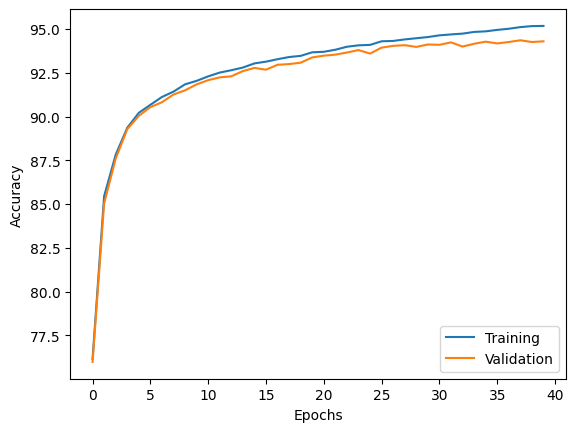
test_mse, test_acc = compute_mse_and_acc(model, X_test, y_test)
print(f'Test accuracy: {test_acc*100:.2f}%')
Test accuracy: 94.13%
12.5. Analysis of failed cases#
X_test_subset = X_test[:1000, :]
y_test_subset = y_test[:1000]
_, probas = model.forward(X_test_subset)
test_pred = np.argmax(probas, axis=1)
misclassified_images = X_test_subset[y_test_subset != test_pred][:25]
misclassified_labels = test_pred[y_test_subset != test_pred][:25]
correct_labels = y_test_subset[y_test_subset != test_pred][:25]
fig, ax = plt.subplots(nrows=5, ncols=5,
sharex=True, sharey=True, figsize=(8, 8))
ax = ax.flatten()
for i in range(25):
img = misclassified_images[i].reshape(28, 28)
ax[i].imshow(img, cmap='Greys', interpolation='nearest')
ax[i].set_title(f'{i+1}) '
f'True: {correct_labels[i]}\n'
f' Predicted: {misclassified_labels[i]}')
ax[0].set_xticks([])
ax[0].set_yticks([])
plt.tight_layout()
plt.show()
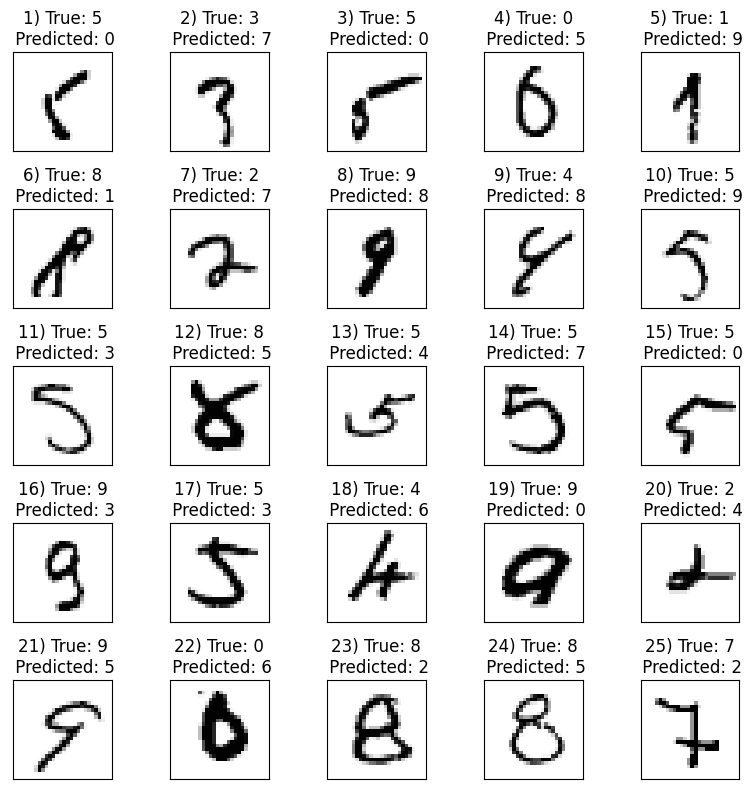
Some of these may not look challenging, still the network fails. For number 7, for example, we can guess that handwritten digit 7 with a horizontal line is underrepresented in our dataset and gets misclassified.
12.6. Other checks and further analysis#
Check image-level predictions
def plot_rand_digit(X,y):
tmp_indx = np.random.randint(len(X))
image_data = np.reshape(X[tmp_indx],(28, 28))
plt.imshow(image_data, cmap='gray')
plt.colorbar()
plt.show()
print("label is: ",y[tmp_indx])
return image_data,X[tmp_indx]
def plot_digit(tmp_indx, X,y):
image_data = np.reshape(X[tmp_indx],(28, 28))
plt.imshow(image_data, cmap='gray')
plt.colorbar()
plt.show()
print("label is: ",y[tmp_indx])
return image_data,X[tmp_indx]
def plot_image(image_data):
plt.imshow(image_data, cmap='gray')
plt.colorbar()
plt.show()
def image_2_X(tmp_image):
return tmp_image.reshape(28*28,)
tmp_image, tmp_imX = plot_rand_digit(X_test,y_test)
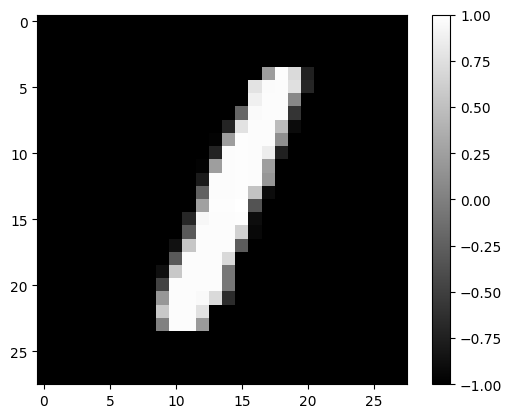
label is: 1
# Rotate the array by 90 degrees
rotated_image = np.rot90(tmp_image)
#rotated_image = np.rot90(rotated_image)
plot_image(rotated_image)
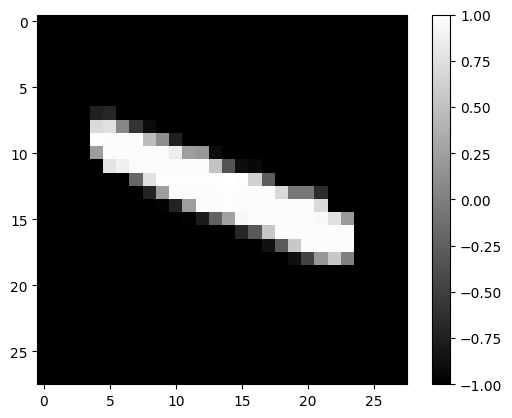
tmp_X = image_2_X(rotated_image)
_, probas = model.forward(tmp_X)
rotated_pred = np.argmax(probas)
print("Predicted label is: ", rotated_pred)
Predicted label is: 4
Visualize in 3D-PCA
import pandas as pd
from sklearn.decomposition import PCA
import plotly.express as px
import plotly.io as pio
from google.colab import files
# Save the plot as an HTML file
def plot_3d_pca(X, y, target_names=None):
# Apply PCA with 3 components
pca = PCA(n_components=3)
X_pca = pca.fit_transform(X)
# Combine the PCA results and target labels
data = np.column_stack((X_pca, y))
# Create a DataFrame with column names
columns = ['PC1', 'PC2', 'PC3', 'label']
df = pd.DataFrame(data, columns=columns)
df['label'] = df['label'].astype(int)
if target_names is not None:
df['label_name'] = df['label'].apply(lambda x: target_names[x])
color_col = 'label_name'
else:
color_col = 'label'
# Create the interactive 3D plot
fig = px.scatter_3d(df, x='PC1', y='PC2', z='PC3', color=color_col, symbol=color_col, text=color_col,
labels={'PC1': 'Principal Component 1', 'PC2': 'Principal Component 2', 'PC3': 'Principal Component 3'})
# Customize the plot appearance
fig.update_layout(
margin=dict(l=0, r=0, t=0, b=0),
scene=dict(
xaxis_title='Principal Component 1',
yaxis_title='Principal Component 2',
zaxis_title='Principal Component 3',
),
)
# Show the plot
#fig.show()
pio.write_html(fig, file="3d_pca_plot.html", auto_open=True)
files.download("3d_pca_plot.html")
return fig
fig = plot_3d_pca(X_test, y_test, ['0','1','2','3','4','5','6','7','8','9'])
12.8. Coding#
Problem 1: Change the hidden layer activation Function to be a ReLU
Hint:
Forward pass
# Hidden layer z_h = np.dot(x, self.weight_h.T) + self.bias_h a_h = np.maximum(0, z_h) # ReLU activation
Backward pass
d_a_h__d_z_h = a_h * (1 - a_h) is replaced with d_a_h__d_z_h = np.where(a_h > 0, 1, 0).
This applies the derivative of ReLU, which is 1 when a_h > 0 and 0 when a_h <= 0.
##########################
### MODEL
##########################
def relu(z):
# ::::::::::: COMPLETE :::::::::::
return
def sigmoid(z):
return 1. / (1. + np.exp(-z))
def int_to_onehot(y, num_labels):
ary = np.zeros((y.shape[0], num_labels)) # [n_examples, n_classes]
for i, val in enumerate(y):
ary[i, val] = 1
return ary
class InitializeModel:
def __init__(self, random_seed=123):
print("Model initialization")
self.random_seed = random_seed
# Set up a common random number generator
self.rng = np.random.RandomState(random_seed)
# Common attribute for all models
self.operation = "Initialization"
class NeuralNetMLP_ReLU(InitializeModel):
def __init__(self, num_features, num_hidden, num_classes, random_seed=123):
super().__init__(random_seed)
"""
self.num_classes = num_classes
# hidden
#rng = np.random.RandomState(random_seed)
self.weight_h = self.rng.normal(
loc=0.0, scale=0.1, size=(num_hidden, num_features))
self.bias_h = np.zeros(num_hidden)
# output
self.weight_out = self.rng.normal(
loc=0.0, scale=0.1, size=(num_classes, num_hidden))
self.bias_out = np.zeros(num_classes)
"""
self.num_classes = num_classes
self.num_features = num_features
self.num_hidden = num_hidden
self._initialize_weights()
def _initialize_weights(self):
"""Initialize weights and biases with random values."""
# Initialize hidden layer weights and biases
self.weight_h = self.rng.normal(
loc=0.0, scale=0.1, size=(self.num_hidden, self.num_features))
self.bias_h = np.zeros(self.num_hidden)
# Initialize output layer weights and biases
self.weight_out = self.rng.normal(
loc=0.0, scale=0.1, size=(self.num_classes, self.num_hidden))
self.bias_out = np.zeros(self.num_classes)
def reinitialize(self, random_seed=None):
"""Reinitialize the model weights and biases if you need to."""
if random_seed is not None:
self.rng = np.random.RandomState(random_seed)
self._initialize_weights()
def forward(self, x):
# Hidden layer
# input dim: [n_examples, n_features] dot [n_hidden, n_features].T
# output dim: [n_examples, n_hidden]
z_h = np.dot(x, self.weight_h.T) + self.bias_h
# ::::::::::: COMPLETE :::::::::::
a_h = # ReLU activation
# Output layer
# input dim: [n_examples, n_hidden] dot [n_classes, n_hidden].T
# output dim: [n_examples, n_classes]
z_out = np.dot(a_h, self.weight_out.T) + self.bias_out
a_out = sigmoid(z_out)
return a_h, a_out
def backward(self, x, a_h, a_out, y):
#########################
### Output layer weights
#########################
# onehot encoding
y_onehot = int_to_onehot(y, self.num_classes)
# For simplicity, the loss function is assumed to be the same we saw in Adaline, that is an MSE
# Loss = 1/n \sum_{i=1}^{n} 1/t \sum_{j=1}^{t} (y^{i}_{j}-outa^{i}_{j})^2
# Later on we will look at other loss functions such as multi-category cross-entropy loss
# Part 1: dLoss/dOutWeights
## = dLoss/dOutAct * dOutAct/dOutZ * dOutz/dOutWeight
## where DeltaOut = dLoss/dOutAct * dOutAct/dOutZ
## for convenient re-use
# input/output dim: [n_examples, n_classes]
d_loss__d_a_out = 2.*(a_out - y_onehot) / y.shape[0]
# input/output dim: [n_examples, n_classes]
d_a_out__d_z_out = a_out * (1. - a_out) # sigmoid derivative (<--- demonstrate)
# output dim: [n_examples, n_classes]
delta_out = d_loss__d_a_out * d_a_out__d_z_out # "delta (rule) placeholder"
# gradient for output weights
# [n_examples, n_hidden]
d_z_out__dw_out = a_h
# input dim: [n_classes, n_examples] dot [n_examples, n_hidden]
# output dim: [n_classes, n_hidden]
d_loss__dw_out = np.dot(delta_out.T, d_z_out__dw_out)
d_loss__db_out = np.sum(delta_out, axis=0) # [n_classes]
#################################
# Part 2: dLoss/dHiddenWeights
## = DeltaOut * dOutZ/dHiddenAct * dHiddenAct/dHiddenZ * dHiddenZ/dWeight
# [n_classes, n_hidden]
d_z_out__a_h = self.weight_out
# output dim: [n_examples, n_hidden]
d_loss__a_h = np.dot(delta_out, d_z_out__a_h)
# [n_examples, n_hidden]
# ::::::::::: COMPLETE :::::::::::
d_a_h__d_z_h =
# [n_examples, n_features]
d_z_h__d_w_h = x
# output dim: [n_hidden, n_features]
d_loss__d_w_h = np.dot((d_loss__a_h * d_a_h__d_z_h).T, d_z_h__d_w_h)
d_loss__d_b_h = np.sum((d_loss__a_h * d_a_h__d_z_h), axis=0)
return (d_loss__dw_out, d_loss__db_out,
d_loss__d_w_h, d_loss__d_b_h)
#********************************************************#
#****************** THE MODEL *********************#
#********************************************************#
model_relu = NeuralNetMLP_ReLU(num_features=28*28,
num_hidden=50,
num_classes=10)
#********************************************************#
#********************************************************#
#********************************************************#
Model initialization
np.random.seed(123) # for the training set shuffling
#model.reinitialize()
epoch_loss, epoch_train_acc, epoch_valid_acc = train(
model_relu, X_train, y_train, X_valid, y_valid,
num_epochs=40, learning_rate=0.1)
Epoch: 001/040 | Train MSE: 0.0206 | Train Acc: 88.81% | Valid Acc: 88.84%
Epoch: 002/040 | Train MSE: 0.0163 | Train Acc: 90.78% | Valid Acc: 90.74%
Epoch: 003/040 | Train MSE: 0.0143 | Train Acc: 91.97% | Valid Acc: 91.54%
Epoch: 004/040 | Train MSE: 0.0125 | Train Acc: 92.92% | Valid Acc: 92.72%
Epoch: 005/040 | Train MSE: 0.0117 | Train Acc: 93.40% | Valid Acc: 93.10%
Epoch: 006/040 | Train MSE: 0.0110 | Train Acc: 93.83% | Valid Acc: 93.26%
Epoch: 007/040 | Train MSE: 0.0103 | Train Acc: 94.36% | Valid Acc: 93.94%
Epoch: 008/040 | Train MSE: 0.0098 | Train Acc: 94.52% | Valid Acc: 94.08%
Epoch: 009/040 | Train MSE: 0.0091 | Train Acc: 94.91% | Valid Acc: 94.50%
Epoch: 010/040 | Train MSE: 0.0089 | Train Acc: 95.09% | Valid Acc: 94.74%
Epoch: 011/040 | Train MSE: 0.0085 | Train Acc: 95.40% | Valid Acc: 94.82%
Epoch: 012/040 | Train MSE: 0.0083 | Train Acc: 95.44% | Valid Acc: 94.82%
Epoch: 013/040 | Train MSE: 0.0078 | Train Acc: 95.75% | Valid Acc: 95.16%
Epoch: 014/040 | Train MSE: 0.0079 | Train Acc: 95.81% | Valid Acc: 95.28%
Epoch: 015/040 | Train MSE: 0.0075 | Train Acc: 95.92% | Valid Acc: 95.22%
Epoch: 016/040 | Train MSE: 0.0074 | Train Acc: 96.02% | Valid Acc: 95.30%
Epoch: 017/040 | Train MSE: 0.0070 | Train Acc: 96.21% | Valid Acc: 95.50%
Epoch: 018/040 | Train MSE: 0.0070 | Train Acc: 96.26% | Valid Acc: 95.54%
Epoch: 019/040 | Train MSE: 0.0069 | Train Acc: 96.26% | Valid Acc: 95.24%
Epoch: 020/040 | Train MSE: 0.0069 | Train Acc: 96.39% | Valid Acc: 95.72%
Epoch: 021/040 | Train MSE: 0.0063 | Train Acc: 96.62% | Valid Acc: 95.66%
Epoch: 022/040 | Train MSE: 0.0062 | Train Acc: 96.68% | Valid Acc: 95.80%
Epoch: 023/040 | Train MSE: 0.0061 | Train Acc: 96.80% | Valid Acc: 95.74%
Epoch: 024/040 | Train MSE: 0.0061 | Train Acc: 96.72% | Valid Acc: 95.74%
Epoch: 025/040 | Train MSE: 0.0059 | Train Acc: 96.87% | Valid Acc: 96.08%
Epoch: 026/040 | Train MSE: 0.0060 | Train Acc: 96.87% | Valid Acc: 95.88%
Epoch: 027/040 | Train MSE: 0.0057 | Train Acc: 96.94% | Valid Acc: 96.00%
Epoch: 028/040 | Train MSE: 0.0054 | Train Acc: 97.12% | Valid Acc: 96.14%
Epoch: 029/040 | Train MSE: 0.0054 | Train Acc: 97.06% | Valid Acc: 96.14%
Epoch: 030/040 | Train MSE: 0.0055 | Train Acc: 97.10% | Valid Acc: 96.20%
Epoch: 031/040 | Train MSE: 0.0052 | Train Acc: 97.21% | Valid Acc: 96.10%
Epoch: 032/040 | Train MSE: 0.0053 | Train Acc: 97.13% | Valid Acc: 96.04%
Epoch: 033/040 | Train MSE: 0.0052 | Train Acc: 97.20% | Valid Acc: 96.18%
Epoch: 034/040 | Train MSE: 0.0050 | Train Acc: 97.32% | Valid Acc: 96.26%
Epoch: 035/040 | Train MSE: 0.0050 | Train Acc: 97.33% | Valid Acc: 96.22%
Epoch: 036/040 | Train MSE: 0.0049 | Train Acc: 97.40% | Valid Acc: 96.18%
Epoch: 037/040 | Train MSE: 0.0048 | Train Acc: 97.41% | Valid Acc: 96.38%
Epoch: 038/040 | Train MSE: 0.0048 | Train Acc: 97.47% | Valid Acc: 96.34%
Epoch: 039/040 | Train MSE: 0.0047 | Train Acc: 97.50% | Valid Acc: 96.22%
Epoch: 040/040 | Train MSE: 0.0048 | Train Acc: 97.44% | Valid Acc: 96.30%
test_mse, test_acc = compute_mse_and_acc(model_relu, X_test, y_test)
print(f'Test accuracy: {test_acc*100:.2f}%')
Test accuracy: 96.09%


